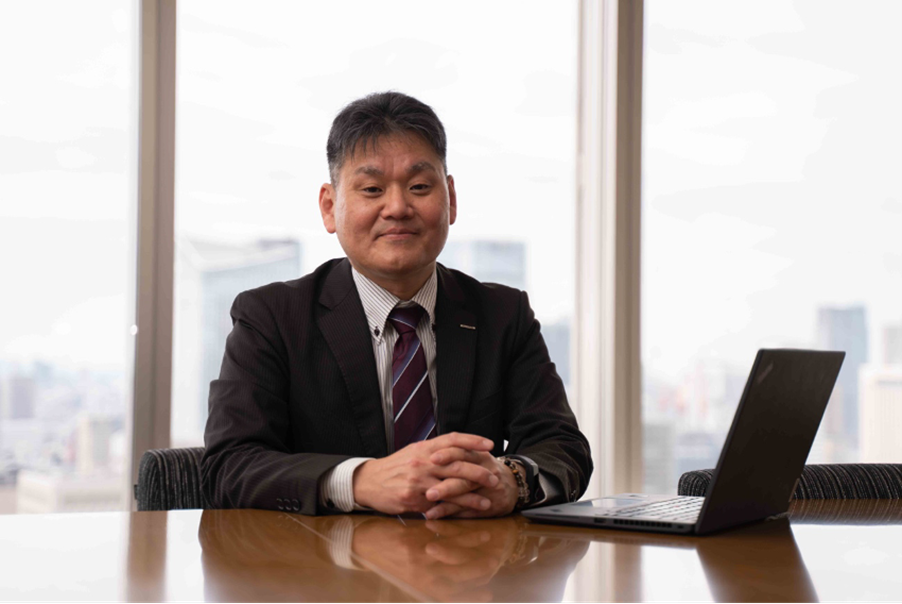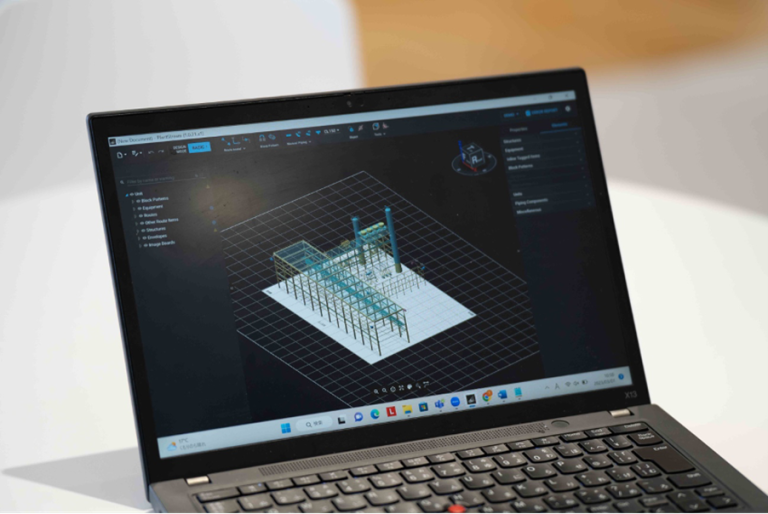User Interview
Celebrating its 100th anniversary in 2022, Asahi Kasei Corporation (hereafter, Asahi Kasei) is a comprehensive chemical manufacturer engaged in a diverse range of businesses, including materials such as chemicals, fibers, and electronics, housing and construction materials, as well as healthcare areas like pharmaceuticals, medical devices, and critical care. The company employs a multi-faceted approach in its business operations, focusing on material fields, housing-related sectors, and healthcare domains.
The production plants impact product quality and significantly influence operational costs from a cost perspective during plant construction. To address this, Asahi Kasei has implemented an owner engineering system, where Corporate Production Technology takes charge of everything from plant consideration to design, procurement, construction, and maintenance.
In this interview, we spoke with Mr. Kazufumi Ezaki, Senior Professional Chemical Engineer Lead Expert and Senior Manager at the Plants Projects Department Engineering Center within the Corporation Production Technology at Asahi Kasei, about their active promotion of Digital Transformation (DX). As the company expands its business and plans to construct its own plants in North America and Europe, challenges such as increased workload and a shortage of engineers have emerged. As a solution to these challenges, Asahi Kasei is exploring the introduction of “PlantStream,” a 3D CAD software with strengths in automatic routing of piping and cables.
Significant Improvement in Design Accuracy & Speed in FS/FEED stage with PlantStream: Enabling Engineers to Focus More on other Core Task of Basic Design engineering.
Exploring the Significant Potential of PlantStream Experienced by Asahi Kasei
User Applied Case Interview with Engineering Department of a Comprehensive Chemical Manufacturer

PlantStream was a perfect fit for the challenges we faced in the FS/FEED process – material quantity calculation.
― First, could you share the background leading up to the introduction of PlantStream? As an engineer and someone in a position to nurture and support the next generation, are you generally highly sensitive to the latest information on ICT tools and products?
Ezaki:Absolutely. I stay highly attuned to industry trends and cutting-edge technology. I attend exhibitions like the “Plant Show” and “Digital Construction Expo,” where the latest solutions gather, and stay informed through online sources and publications. Seeing, hearing, and experiencing the products firsthand at these exhibitions helps me truly understand the strengths and possibilities of each product.

(Kazufumi Ezaki / Senior Professional Chemical Engineer Lead Expert, Senior Manager, Plants Project Dept. Engineering Center, Corporate Production Technology, Asahi Kasei Corporation)
― Did you encounter PlantStream at one of these exhibitions?
Ezaki:PlantStream was introduced to me by another department, and subsequently, we received a software presentation from PlantStream.
Given my regular exposure to various solutions, as I learned about PlantStream’s features, ideas about its potential applications started expanding in my mind. Simultaneously, I began to envision that leveraging PlantStream could potentially address the challenges we currently face in our engineering tasks.
― What are the current challenges in engineering?
Ezaki:As the Owner’s Engineering division of Asahi Kasei, we are involved in the “modification” or “expansion” of existing plants and, in the case of new plants, from the “planning” stage onwards. It’s crucial to vividly imagine and set goals for everything, including construction feasibility, construction schedule, costs, safety, and environmental assessments from the initial phases of FS/FEED, as these factors have a significant impact on accurate business decisions.
This is because having a precise and speedy grasp of quantities such as machinery, piping, electrical systems, and instrumentation, as well as material estimates and rough cost estimates, can lead to accurate business decisions. However, in the past, a significant amount of time was spent improving accuracy in the FS/FEED stage. One contributing factor was the “high barrier of 3D design.” Existing 3DCAD software is complex to operate, and mastering the specialized skills takes time.
Additionally, with each layout change, such as case studies, we had to spend time modifying 3D models created externally by design companies. However, after exploring the usability and development philosophy of PlantStream, we felt that it could be a solution to our challenges. We quickly proceeded with internal discussions and decided to conduct a one-year trial introduction from April 2022.
Turning Engineers’ Envisioned Routings into Reality in an Instant: Astonished by the Speed and Accuracy.
― How was the user experience during the trial introduction?
Ezaki:We selected 10 engineers responsible for machinery, electrical work, and instrumentation in various regions such as Nobeyama, Kawasaki, and Mizushima* and had them use PlantStream. The feedback we received emphasized the high usability in terms of “easy and smooth operations” and the ability to intuitively design in 3D.
Personally, I felt that the ability to easily layout units and pipe racks with just drag-and-drop, a feature not present in other 3D CAD software, was outstanding. The most attractive feature was the “automatic routing” function. By creating pipe racks in the data, specifying the “start” and “end” points of each pipe, and clicking once, the pipe routing plan was completed. Even for hundreds or thousands of pipes, they were visualized on the data in just seconds, significantly enhancing design productivity.
*Nobeyama, Kawasaki, and Mizushima: Japanese place names

Ezaki:Moreover, PlantStream incorporates the vast expertise of skilled engineers into its algorithms, ensuring high planning accuracy. In the “material tally,” we were able to easily and quickly calculate pipe length, weight, steel weight, cable length, etc., in alignment with the completed 3D drawings. Another positive aspect was that, in communication with contractors, we confirmed that by using PlantStream for quantity surveying, we could assess the quantities proposed by the contractors.
― The visualization of costs and quantities seems to have brought significant benefits internally and externally.
Ezaki:Another point worth mentioning is that in the FS/FEED process, engineers can now create designs reflecting their intentions. This allows engineers to focus more on the “basic design,” a crucial aspect given the shortage of technical personnel.
To Harness ICT Tools to the Fullest, the Thoughtfulness of Engineers is Paramount.
― Speaking of the “shortage of engineers,” utilizing ICT tools like PlantStream to enhance quality and productivity seems crucial for making the most of limited engineering resources. What are your thoughts?
Ezaki:Absolutely. The shortage of engineers is not unique to the plant industry but extends to peripheral industries like civil engineering, construction, architecture, and manufacturing. As Asahi Kasei, we advocate for the “digital transformation of all employees” and are engaged in various initiatives, including the development and acquisition of digital professionals, creating new businesses, and research and development. In our Corporate Production technology, we have a mission to “actualize the world’s best production technology as a business,” and we’re not limiting ourselves to Japan but also constructing new factories overseas.
Going back a bit, when I was a young engineer working on plant design in the Asian region, I remember a funny incident. In the midst of a tight schedule, while trying to give instructions to local contractors by spreading out paper drawings, my sweat dripped onto the drawings where I had written in red comments. The comments became blurred and illegible because of the sweat. It’s a humorous anecdote now, but at that time, it was frustrating to redo red comments or correct drawings amidst a tight schedule. I don’t want today’s young engineers to go through such unnecessary tasks. Of course, this is just an example.
Nowadays, with the advent of various technologies like AI, digital twins, BIM/CIM, XR, etc., bottlenecks like “It would be great if it could be like this” or “I don’t want to spend time on this” can be easily resolved. I believe we are approaching an era where these issues can be smoothly addressed.
While PlantStream is a fantastic tool that turns what engineers envision into reality instantly, the most crucial aspect for engineers is the power of thoughtful consideration. Engineers need to go through trial and error and hone their thinking skills, as no matter how powerful the tools are, they won’t add value without that.
That’s why I believe it’s essential to reflect on and undergo the complexities of design in one’s 20s and 30s. Whether you’ve experienced the elation and satisfaction of constructing a factory over several years becomes a source of inspiration for you as an engineer. I’m confident that this experience will eventually become a substantial asset for Asahi Kasei.
If Asahi Kasei’s expertise can be algorithmically formalized, the transfer of technical knowledge to younger generations can also be achieved through PlantStream.
― Indeed, ICT tools are means, and the value is created in the engineer’s mind. Finally, with expectations, do you have any requests or hopes for PlantStream?
Ezaki:PlantStream boasts strength in “automatic routing of pipes and cables,” and its algorithms are excellent. Even experienced engineers find that it suggests routings that are accurate.
If we could algorithmize Asahi Kasei’s engineers’ know-how, I believe it could lead to even more innovative solutions. Design philosophies vary among companies, and even within Asahi Kasei, individuals may have subtly different approaches.
While there’s no absolute right answer, if we could perform 3D design using the algorithm based on Asahi Kasei standards, it could change the design world significantly. So far, know-how and skills have been too personalized, making it challenging for the transfer of technology to young engineers. Employing PlantStream has the potential to transform the approach from “learning by watching” to “understanding by doing.
It might not be straightforward, but certainly not impossible. In that regard, we are open to providing feedback from the field, engaging in discussions with PlantStream, and progressing forward together with PlantStream.

(From left: Mr. Iida, Mr. Maruko, Mr. Ezaki, and Mr. Takakuwa of the Corporate Production Technology, Engineering Center)
Recommended Interviews
Book a Demo Today
Connect with an expert to start your PlantStream journey.
Realize more efficient 3D plant design through seamless workflows.
